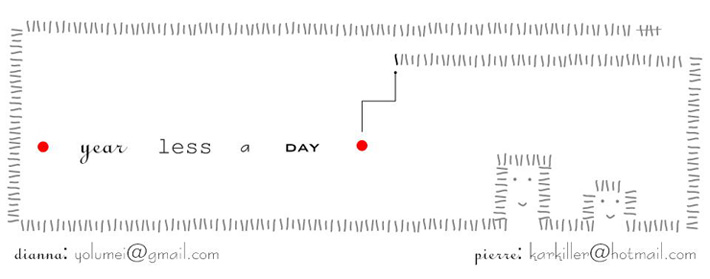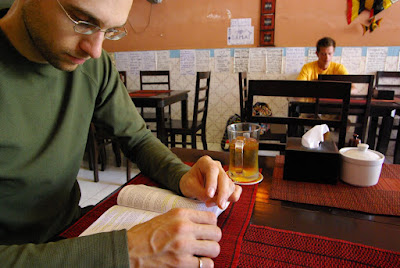It may sound strange, but there's something quirky-charming about a place where a museum has to remind guests to "Please deposit all bags, cameras and weapons at the front counter." ("But I'm trying to expose my handgun and rifle to more culture...") Raisins and bottled water don't seem to be on their hit list so we carry these around as a snack. The windows are open and have no glass, so there's a really nice breeze.
Later, I can't remember much about the statues but I remember a whole lot about which windows and doorways provided the best breezes.


During our walk around the grounds we meet an old man that seems to be the wat-keeper and who opens up the shrine for us with his keys.

We kneel on the floor, feet pointing away from the Buddha and our host, as is polite. We aren't naturals at this uncomfortable kneeling position, especially on stone floors, but we manage to keep it up during our short visit. The man turns on the neon lights around Buddha's head and they flicker slightly out of time with the tune he starts on the CD player which is simple and cheerful, like a Cambodian version of "It's a Small World."

He speaks no English, we speak no Khmer, so we make gestures to let him know the shrine is beautiful and that we'll return later with a donation for Buddha since we have no small bills. He says what sounds like a little prayer and flicks jasmine water on our heads, pours a little in our hands, and gestures that we should rub it on our faces. The water is scented with fresh jasmine flowers - I find a few dried up petals stuck in Pierre's stubble later when we sit down to eat later.
Our spot of choice to cool off and eat up before the Royal Palace is the Khmer Saravan restaurant (#16 Sothearos Street), which seems to be one of Phnom Penh's best kept secrets. The guidebooks don't list it but it comes highly recommended by their former customers, who provide multi-lingual rave reviews that paper the walls. (you can see some of them behind the man in the yellow shirt here) :
The reviews are in Swedish, Polish, French, Russian, Chinese, German, Greek, Portuguese and more. We figure out the languages thanks to a mix of playing hey-what's-that-alphabet and reading the city names that the reviewers sometimes include under their signatures. We don't know what most of them say, but they're peppered with hearts, smiley faces and exclamation points next to the names of several of the dishes. The reviews must be replaced frequently because the restaurant has been around quite awhile but none are dated much later than a month and a half ago. The food is really excellent and well priced and we eat here many times during our days in Phnom Penh.
After lunch, we head back to Wat Ounalom to deliver the donation to Buddha (Pierre is our team rep and places it in his palm on our behalf) and then we take a tour of the area around the wat which seems to be a mix of homes and monks' quarters. There are a lot of orange and saffron sheets hung out to dry on clotheslines, and people sitting in the shade selling fruit and snacks.

Finally, we head over to the Grand Palace so Pierre can finally take some pictures of it - we've waited until late afternoon so that the light will be at its best. The grounds remind me a bit of the Palace in Bangkok, but smaller and slightly more run down. I wander from one puddle of shade to another while Pierre photographs everything. The Palace itself is off-limits since the royal family lives there, but we see the throne hall and other buildings:


and the Silver Pagoda, which looks pretty similar from the outside:

 Photography isn't allowed inside the Silver Pagoda, but the floor is covered with silver tiles, a few of which are cordoned off and left bare so we can admire them. It must take a lot of work to keep the floor from constantly tarnishing in the Cambodian climate, especially during the wet season. The rest of the tiles are protected by large woven rugs that allow us to walk around the pagoda without damaging the tiles. We check out the standing, life-sized Buddha the pagoda is famous for (after its silver floor, of course) - the statue is made of gold and decorated with "9584 diamonds, the largest of which is ... 25 carats." It's impressive but I can't help imagining Buddha seeing this statue of himself and saying "You know, that type of thing wasn't really my point at all..." Still, very beautiful and impressive especially since these are some of the few things that survived the Khmer Rouge 70s unscathed - these were kept around as the regime's proof that they were not destroying all of Cambodia's treasures (just most of them).
Photography isn't allowed inside the Silver Pagoda, but the floor is covered with silver tiles, a few of which are cordoned off and left bare so we can admire them. It must take a lot of work to keep the floor from constantly tarnishing in the Cambodian climate, especially during the wet season. The rest of the tiles are protected by large woven rugs that allow us to walk around the pagoda without damaging the tiles. We check out the standing, life-sized Buddha the pagoda is famous for (after its silver floor, of course) - the statue is made of gold and decorated with "9584 diamonds, the largest of which is ... 25 carats." It's impressive but I can't help imagining Buddha seeing this statue of himself and saying "You know, that type of thing wasn't really my point at all..." Still, very beautiful and impressive especially since these are some of the few things that survived the Khmer Rouge 70s unscathed - these were kept around as the regime's proof that they were not destroying all of Cambodia's treasures (just most of them).
There are ponds, puddles and stupas just outside the pagoda:


Slightly out of place on the grounds is this beautiful little iron house, closed to the public at the moment, which the guidebook says was "given to King Norodom by Napoleon III of France."


We check out the detailing on the gates:

...and the Ramayana murals that line the outer walls of the Silver Pagoda grounds. These are similar to the ones that we saw on the Bangkok palace grounds but they've had a rougher time of it, probably suffering a bit of defacement during the Khmer Rouge regime in the late 70s as well as general neglect and exposure to the elements.
We catch a trippy Buddha shot on our way out of the grounds:
photo credits: P, P, P, P, D, P, D, P, P, P, P, P, P, P, P, P, P, D, D, D







No comments:
Post a Comment